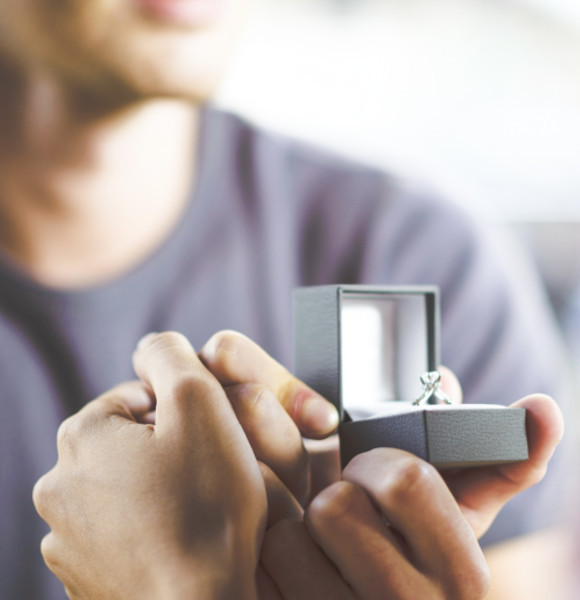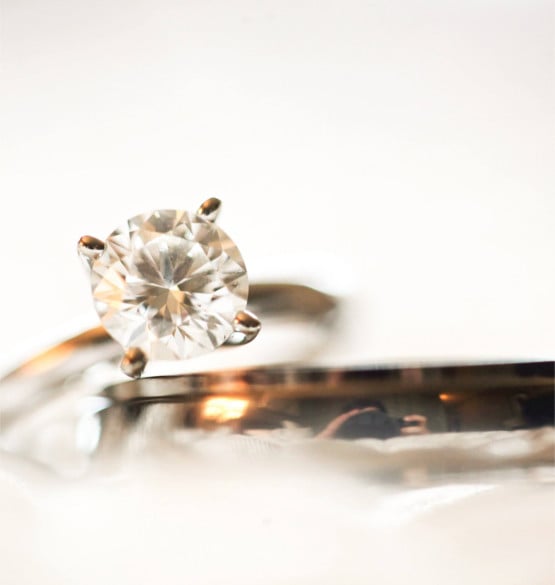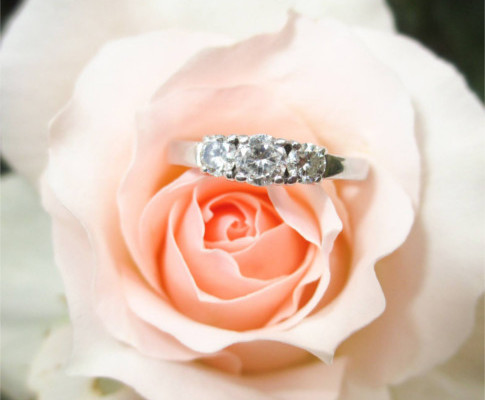6 Steps to Buying the Perfect Engagement Ring

Buying an engagement ring is a major milestone for the relationship and a serious financial commitment as well. You want the perfect ring...but you need it to be within budget. There are so many choices for engagement rings that the hunt may seem overwhelming. For those who are about to jump into the engagement ‘ring,’ here’s a step-by-step checklist when shopping for that dream ring!

Step 1: Decide on a Centerpiece Stone.
Almost every engagement ring has a prominent centerpiece stone. While some rings are designed as three-stone rings, the middle stone in those designs are typically still slightly larger than the side stones. If your mind is set on a diamond, then you need to figure out what shape you want for your centerpiece. Even gemstones are offered in a variety of shapes.
If you want to slenderize your finger, choose vertical shapes like oval, pear or marquise. Want lots of fire and brilliance? Round brilliant, oval, radiant, and princess shapes offer amazing sparkle. Asscher and emerald shapes feature shiny step facets within their cut; while they don’t exude the fire of brilliant cuts, step facets are extremely sophisticated and chic and are the go-to looks for vintage-inspired settings. The cushion cut is an old shape that also has a vintage appeal. And heart shaped stones add whimsy and romance to a setting.
Overwhelmed yet? We know there are so many choices! And while it may be hard to choose just one centerpiece shape, the center stone sets the look for the ring.
After you’ve decided on a shape, then you need to figure out stone size and quality. For diamonds, the 4Cs are your guide. Cut, color, clarity, and carat directly affect the price (and beauty!) of a diamond. But certification is also an important factor when deciding to purchase a loose stone. Why? Because only diamonds that have been certified and graded by one of the leading gemstone laboratories can be assured to be authentic and of quality.
Certified stones receive grades in cut, clarity, and color. The certificate issued by the labs also notes carat size as well as other details about the stone (including fluorescence and the types of blemishes and inclusions found in or on the stone). Let’s look closer at the 4Cs.
- Cut: Cutting a diamond is a mathematically precise art. For every shape, there are a certain number of facets that must be present for ideal beauty. These facets must be cut correctly. And the stone must also have the right proportions for the cut to be deemed ‘ideal.’ The cut grades are Ideal, Excellent, Very Good, Good, Fair and Poor.
- Color: A diamond’s color is graded (by GIA) on a scale of D to Z. The letter D indicates colorless, whereas Z is light yellow. Then, of course, there are variants in between as the letters increase on the scale. If your budget is tight, you might opt to downgrade this C as warmer hued diamonds may be masked in yellow gold.
- Clarity: Think of clarity as the clearness of a diamond. Clarity ranges from Flawless (FL) to Included (I) and is based on the appearance of inclusions under 10x magnification. Flawless stones are incredibly rare and pricey. Internally Flawless (IF), Very Very Slightly Included (VVS), Very Slightly Included (VS), and Slightly Included (SI) are all in-between grades.
- Carat is the fourth C. Larger stones are expensive and even a single decimal point in carat weight can make a significant difference in the price of a stone. Prices will jump when buyers opt for a full-carat weight, but the difference in size between a 0.90 carat diamond and a full carat is barely noticeable.

Colorful gemstones don’t follow the same grading scales as a diamond. When shopping for gemstones, focus on color saturation and the hardness of the stone. The hue of a gemstone affects its value.
More vibrant colors—think rich reds for rubies—command a higher price. You also need to be careful when selecting softer stones (like opal) as a centerpiece for your ring. Softer gems can shatter and break easily, so daily wear may be a bit too much for these stones.
Step 2: Choose your metal and setting.
You’ve found that perfect stone, now check it off your list! The next step is discovering which metal to choose for your setting.
The most popular metal for engagement rings is white gold
Research different setting styles to find the best band for your dream ring.

Step 3: Decide on Details
Do you want to add side stones next to your center stone? Or maybe you’d like pave diamond accents set within the band. After you’ve selected an ideal setting style, now it’s time to include any additional details for a personalized touch. Some buyers love to add birthstones next to a center diamond. You can include your birthstone next to his/her birthstone. Of course, diamond side stones always look amazing. Just be sure to choose a side stone that compliments the shape of your center stone. Adding a halo around a center stone also draws attention to the centerpiece. Create a halo using colorful gemstones, diamonds or even seed pearls (for antique appeal).
If you’re happy with your ring and you don’t want additional design elements, you may want to consider engraving a personal sentiment within the inside of the band. Engrave anything your heart desires including initials, a monogram, a simple quote or perhaps the date of the engagement with “I love you.”

Step 4: Figure out payment arrangements.
Before you can walk away with the ring, you need to figure out how you plan to pay for it. Many stores (including Brilliance!) offer payment plans.
Shopping for an engagement ring isn’t a simple process. You need to set your budget, research your buying options and then figure out the details of the ring--always balancing needs, aspirations, and budget. Spend all the time you need talking to experienced jewelers who will help you make the right decisions.
Step 5: Consider purchasing ring insurance.
An engagement ring is an expensive investment. To protect against damage or theft, think about purchasing an insurance policy for your engagement ring. If you have a homeowner’s policy or renter’s insurance, you can typically add an umbrella policy that covers valuables like jewelry. However, you will need to have the ring appraised. Talk to your insurance provider to inquire about the specific coverage they recommend.
Step 6: Plan the proposal!
Congratulations! You have purchased the perfect engagement ring! Now you need to think about how you plan to pop the question. Every proposal is unique to the couple, and your proposal will be a memory that will last a lifetime. Just don’t forget to snap a few photos...and a ring selfie!

